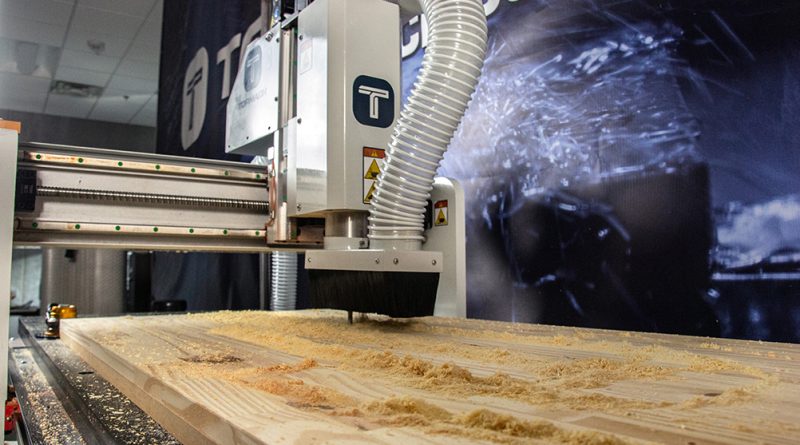Here’s your comprehensive guide to Feeds and Speeds for Wood, together with Tips and Techniques that are specific to cutting wood on a CNC Machine.
Wood Types
When calculating feeds and speeds for wood, we generally look at 4 different famillies. You can see them in our G-Wizard Feed and Speed Calculator’s Material menu:
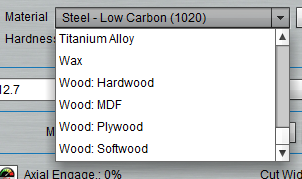
Just 4 wood types? Why not more?
To access the full variety of woods under each family, use the “More…” button on G-Wizard.
People wonder why we don’t have a lot more categories.
The short answer answer is that there are hundreds of sub-categories corresponding to individual wood species accessible via the “More” button. Use them if you need to fine tune for maximum performance.
But, for basic roughing work, also be aware that you can do a lot with just the main sub-categories. This is due to the size of the “sweet spot” that relates feeds and speeds to good results in a material, together with the relative hardness of the woods (or other materials) versus the cutters (HSS or Carbide).
The Sweet Spot determines how the relationship between speed (spindle rpm) and feedrate need to come together for good cutting results. A typical Sweet Spot looks like this schematically:
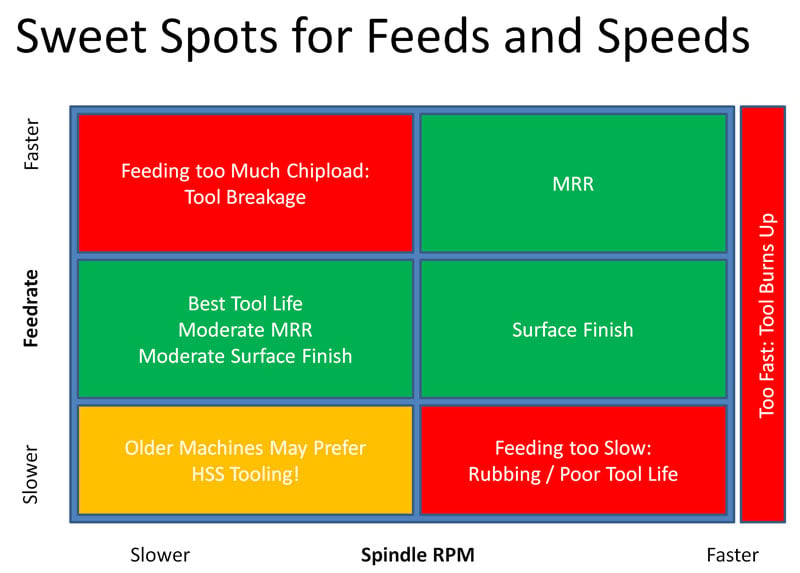
The green areas reflect ideal Sweet Spot matches for a material and cutting conditions. You can optimize MRR (Material Removal Rate), Surface Finish, and to an extent a blend of all three. Red reflects danger zones.
It’s important to note you can get into just as much trouble running too slowly (due to rubbing) as running too quickly.
Tools usually fail for a couple of main reasons:
– They get too hot, which softens the tool and results in a dull edge. Tools have a certain maximum speed, called the “Surface Speed” that governs how fast they can run against a given material. Running too slowly relative to feeds also generates a lot of heat due to Rubbing. This destroys a tool gradually, though gradual can mean a matter of minutes if the tool is hot enough.
– Tools can break because the flutes get too full, the chips have no place to go, and the tool jams and snaps off. This destroys a tool suddenly and is more commonly what beginners see.
A lot else can shorten a tools life–chipped edges in some materials, materials like stainless steel can “work harden” and suddenly become much harder during the cutting process, and some materials like aluminum try to weld themselves to the cutting edge if lubricant or appropriate tool coatings are not used. But, over heating and chip loading are the two main tool life enemies that are directly feeds and speeds related.
You can learn all this and much more from our free Feeds and Speeds Tutorial, but for now, let’s stay with this idea of a Sweet Spot. In general, the sweet spots for woods are much larger than for metals. For harder steels and difficult materials like Titanium, the sweet spot gets very small indeed. Imagine there are actual numbers on our Sweet Spot diagram. “Size” of Sweet Spot refers to how wide a range of numbers are safe.
What determines the “Size” of a Sweet Spot?
A lot of this is all up to that relative difference in hardness between material and cutter. Even Carbide is not all that much harder than hardened steel whereas it is phenomenally harder than even the hardest woods. Red Oak, for example, has a Brinell Hardness of about 3.7. Mild steel is 120, hardened steel is 900, and tungsten carbide is 4000!
It turns out that the characteristics that affect the feeds and speeds for wood are different than hardness. They have to do for example with the behavior of the sap relative to the sawdust and how the chips are made.
Plastics, similarly, can behave differently–hard plastics as a name is a bit of a misnomer (though it is the industry standard in tooling catalogs). It refers to the chipping characteristics of the plastic. Hard Plastic turns to dust–it shatters. Soft Plastics allow a nice clean chip to be sliced off, almost like you slice cheese with a knife.
Of course, the same is true for woods. “Hard” Wood versus “Soft” Wood has more to do with the seeds of the Wood than the actual hardness. Balsa seems soft but is technically a Hardwood. Hardwood seeds have a covering–shell or fruit, while Softwood does not.
Another factor influencing all this has to do with manufacturing process for the material. In the case of materials like MDF and Plywood, their manufacture can result in abrasive grit being embedded in the layers and that grit matters more than the wood in feeds and speeds.
This is why so much router work prefers Carbide tooling even though wood is relatively soft. HSS just doesn’t stand up to that kind of grit very well.
With all that said, there are still differencs in hardness for various woods, and there is a standard scale, called the “Janka” scale that is used to rate the relative hardness of various woods.
Improve My Feeds and Speeds for Softwoods
Here are the various softwoods, sorted by Janka hardness, that one might attempt to CNC:
Common Name Scientific Name Janka Metric Hardness
K-N
Janka Imperial Hardness
lb-feet
balsa Ochroma pyramidale 0.4 90 ceiba Ceiba pentandra 1.1 240 cottonwood – balsam poplar Populus balsamifera 1.3 300 white-cedar, northern Thuja occidentalis 1.4 320 aspen, quaking Populus tremuloides 1.6 350 buckeye, yellow Aesculus octandra 1.6 350 cedar, atlantic white Chamaecyparis thyoides 1.6 350 cottonwood, black Populus trichocarpa 1.6 350 fir, subalpine Abies lasiocarpa 1.6 350 red cedar, western Thuja plicata 1.6 350 willow, black Salix nigra 1.6 360 cuangare Dialyanthera spp. 1.7 380 okoume Aucoumea klaineana 1.7 380 pine, eastern white Pinus strobus 1.7 380 pine, sugar Pinus lambertiana 1.7 380 jelutong Dyera costulata 1.7 390 spruce, Engelmann Picea engelmanni 1.7 390 fir, balsam Abies balsamea 1.8 400 basswood, American Tilia americana 1.8 410 basswood, Carolina Tilia caroliniana 1.8 410 fir, noble Abies procera 1.8 410 aspen, bigtooth Populus grandidentata 1.9 420 pine, western white Pinus monticola 1.9 420 redwood, second growth Sequoia sempervirens 1.9 420 sajo Campnosperma panamensis 1.9 425 cottonwood, eastern Populus deltoides 1.9 430 fir, pacific silver Abies amabilis 1.9 430 obeche Triplochiton scleroxylon 1.9 430 pine, limber Pinus flexilis 1.9 430 cypress, Mexican Cupressus lustianica 2 460 pine, ponderosa Pinus ponderosa 2 460 shorea, light red meranti Shorea spp., lauan-meranti group 2 460 incense-cedar Libocedrus decurrens 2.1 470 fir, white Abies concolor 2.1 480 pine, lodgepole Pinus contorta 2.1 480 redwood, old growth Sequoia sempervirens 2.1 480 spruce, white Picea glauca 2.1 480 chalviande Virola spp. 2.1 481 butternut Juglans cinerea 2.2 490 fir, grand Abies grandis 2.2 490 limba Terminalia superba 2.2 490 spruce, red Picea rubra 2.2 490 fir, California red Abies magnifica 2.2 500 hemlock, eastern Tsuga canadensis 2.2 500 pine, Jeffrey Pinus jeffreyi 2.2 500 banak Virola spp. 2.3 510 Douglas-fir, interior south Pseudotsuga menziesii 2.3 510 spruce, Sitka Picea sitchensis 2.3 510 tulapueta Osteophloeum platyspermum 2.3 512 spruce, black Picea mariana 2.3 520 chestnut, American Castenea dentata 2.4 540 hemlock, western Tsuga heterophylla 2.4 540 poplar Liriodendron tulipifera 2.4 540 yellow poplar Liriodendron tulipifera 2.4 540 catalpa, northern Catalpa speciosa 2.4 550 catalpa, southern Catalpa bignonioides 2.4 550 hura Hura crepitans 2.4 550 pine. red Pinus resinosa 2.5 560 baldcypress Taxcodium distichum 2.3 570 pine, jack Pinus banksiana 2.5 570 cedar, Alaska Chamaecyparis nootkatensis 2.6 580 cedar, yellow Cupressus nootkatensis 2.6 580 alder, red Alnus rubra 2.6 590 silverbell, Carolina Halesia carolina 2.6 590 tamarack Larix laricina 2.6 590 Douglas-fir, interior north Pseudotsuga menziesii 2.7 600 Spanish-cedar Cedrela spp. 2.7 600 ilomba Pycnanthus angolensis Exell 2.7 610 red cedar, southern Juniperus silicicola 2.7 610 pine, pitch Pinus rigida 2.8 620 cativo Prioria copaifera 2.8 630 sassafras Sassafras albidum 2.8 630 alder, European Alnus glutinosa 2.9 650 determa Ocotea rubra 2.9 660 Douglas-fir, interior west Pseudotsuga menziesii 2.9 660 pine, spruce Pinus glabra 2.9 660 pine, Table Mountain Pinus pungens 2.9 660 primavera Tabebula donnell-smithii 2.9 660 pulgande Dacryodes spp. 3 666 hemlock, mountain Tsuga mertensiana 3 680 sumac, staghorn Rhus typhina 3 680 pine, loblolly Pinus taeda 3.1 690 pine, shortleaf Pinus echinata 3.1 690 magnolia, cucumber tree Magnolia acuminata 3.1 700 maple, silver Acer saccharimum 3.1 700 Douglas-fir, coast Pseudotsuga menziesii 3.2 710 boxelder Acer negundo 3.2 720 cedar, Port Orford Chamaecyparis lawsoniana 3.2 720 chinkapin, giant Castanopsis chrysophylla 3.2 730 pine, sand Pinus clausa 3.3 730 pine, pond Pinus serotina 3.3 740 pine, virginia Pinus virginiana 3.3 740 birch, gray Betula populifolia 3.4 760 pine, slash Pinus elliotti 3.4 760 shorea, yellow meranti Shorea spp., lauan-meranti group 3.4 770 sycamore, american Platanus occidentalis 3.4 770 parana-pine Araucaria augustifolia 3.5 780 shorea, dark red meranti Shorea spp., lauan-meranti group 3.5 780 mahogany, true Swietenia macrophylla 3.6 800 magnolia, sweetbay Magnolia virginiana 3.6 810 tupelo, black Nyssa sylvatica 3.6 810 elm, american Ulmus americana 3.7 830 larch, western Larix occidentalis 3.7 830 mahogany, African Khaya spp. 3.7 830 elder, blue Sambucus cerulea 3.7 840 ash, black Fraxinus nigra 3.8 850 maple, bigleaf Acer macrophyllum 3.8 850 sweetgum Liquidambar styraciflua 3.8 850 elm, slippery Ulmus rubra 3.8 860 pine, pinyon Pinus edulis 3.8 860 pine, longleaf Pinus palustris 3.9 870 hackberry Celtis occidentalis 3.9 880 tupelo. water Nyssa aquatica 3.9 880 red cedar, eastern Juniperus virginiana 4 900 sande Brosimum spp., utile group 4 900 birch, paper Betula papyrifera 4 910 ekop Tetraberlinia tubmaniana 4.1 910 pine, ocote Pinus oocarpa 4 910 anime Protium spp. 4.1 920 sourwood Oxydendrum arboreum 4.2 940 cherry, black, American Prunus serotina 4.2 950 maple, red Acer rubrum 4.2 950 robe Tabebul spp., roble group 4.3 960 ash, pumpkin Fraxinus profunda 4.4 990
Improve My Feeds and Speeds for Hardwoods
Here are the various hardwoods, sorted by Janka hardness, that one might attempt to CNC:
Common Name Scientific Name Janka Metric Hardness
K-N
Janka Imperial Hardness
lb-feet
teak Tectona grandis 4.4 1000 walnut, black Juglans nigra 4.5 1010 albarco Cariniana spp. 4.5 1020 holly, American Ilex opaca 4.5 1020 magnolia, southern Magnolia grandiflora 4.5 1020 buckthorn, cascara Rhamnus purshiana 4.6 1040 oak, southern red Quercus falcata 4.7 1060 avodire Turraeanthus africanus 4.8 1080 manni Symphonia globulifera 5 1120 andiroba Carapa guianensis 5 1130 oak, chestnut Quercus prinus 5 1130 shorea, white meranti Shorea javanica, lauan-meranti group 5.7 1140 cherry, wild, European Prunus avium 5.1 1150 santa maria Calophyllum brasiliense 5.1 1150 ash, oregon Fraxinus latifolia 5.2 1160 juniper, alligator Juniperus deppeana 5.2 1160 maple, black Acer nigrum 5.2 1180 oak, overcup Quercus lyrata 5.3 1190 oak, water Quercus nigra 5.3 1190 ash, green Fraxinus pennsylvanica 5.3 1200 oak, black Quercus velutina 5.4 1210 oak, laurel Quercus laurifolia 5.4 1210 pine, heart Pinus resinosa 5.5 1225 kapur Dryobalanops spp. 5.5 1230 oak, swamp chestnut Quercus michauxii 5.5 1240 pine, Caribbean Pinus caribaea 5.5 1240 birch, river Betula nigra 5.6 1260 birch, yellow Betula alleghaniensis 5.6 1260 iroko Chlorophora spp. 5.6 1260 keruing Dipterocarpus spp. 5.6 1270 laurel, California Umbellularia californica 5.6 1270 myrtlewood Umbellularia californica 5.65 1270 angelique Dicorynia guianensis 5.7 1290 mersawa Anisoptera spp. 5.7 1290 oak, northern red Quercus rubra 5.7 1290 oak, shumard Quercus shumardii 5.8 1290 beech, American Fagus grandifolia 5.8 1300 ramin Gonystylus bancanus 5.8 1300 alder, white Alnus rhombifolia 5.9 1320 ash, white Fraxinus americana 5.9 1320 elm, cedar Ulmus crassifolia 5.9 1320 elm, rock Ulmus thomasii 5.9 1320 ovangkol Guibourtia ehie 5.9 1330 oak, post Quercus stellata 6 1360 oak, white Quercus alba 6 1360 oak, bur Quercus macrocarpa 6.1 1370 cypress, Australian Callitris glaucophylla 6 1375 coffeetree, Kentucky Gymnocladus dioicus 6,2 1390 oak, scarlet Quercus coccinea 6.2 1400 sepetir Pseudosindora palustris 6.3 1410 tanoak Lithocarpus densiflorus 6.3 1420 maple, sugar (hard) Acer saccharum 6.4 1450 madrone, Pacific Arbutus menziesii 6.5 1460 oak, willow Quercus phellos 6.5 1460 birch, sweet Betula lenta 6.5 1470 oak, cherrybark Quercus falcata varpagodifolia 6.6 1480 hickory, bitternut Carya cordiformis 6.7 1500 merbau Intsia spp. 6.7 1500 pau marfim, Patagonian maple Balfourodendron riedelianum 6.7 1500 oak, pin Quercus palustris 6.7 1510 sapele Entandrophragma cylindricum 6.7 1510 witch hazel Hamamelis virginica 6.8 1530 elm, winged Ulmus alata 6.8 1540 hickory, water Carya aquatica 6.9 1550 afrormosia Pericopsis elata 6.9 1560 honeylocust Gleditsia triacanthos 7 1580 peroba de campos Paratecoma peroba 7.1 1600 yew, Pacific Taxus brevifolia 7.1 1600 oak, swamp white Quercus bicolor 7.2 1620 opepe Nauclea diderrichii 7.3 1630 alder, Nepalese Alnus nepalensis 7.4 1690 locust, black Robinia pseudoacacia 7.6 1700 pilon Hyeronima spp. 7.6 1700 kempas Koompassia malaccensis 7.6 1710 para-angelim Hymenolobium excelsum 7.7 1720 piquia Caryocar spp. 7.7 1720 apple Malus sylvestris 7.7 1730 peroba rosa Aspidosperma spp., peroba group 7.7 1730 tree-of-heaven Ailanthus altissima 7.7 1731 angelin Andira inermis 7.8 1750 benge Guibourtia arnoldiana 7.8 1750 hornbeam, American Carpinus caroliniana 7.9 1780 shorea Shorea spp., baulau group 7.9 1780 ebony, black and white, pale moon Diospyros malabarica 7.9 1790 laurel, mountain Kalmia latifolia 8 1790 serviceberry Amelanchier spp. 8 1800 hickory, shellbark Carya lacinosa 8.1 1810 hickory, pecan Carya illinoensis 8.1 1820 hophornbeam, eastern Ostrya virginiana 8.3 1860 purpleheart Peltogyne spp. 8.3 1860 hickory, shagbark Carya ovata 8.4 1880 jarrah Eucalyptus marginata 8.5 1910 wenge Millettia laurentii 8.4 1930 degame Calycophyllum candidissimum 8.6 1940 hickory. mockernut Carya tomentosa 8.8 1970 pedauk – African Pterocarpus soyauxii 8.6 1970 ash, blue Fraxinus quadrangulata 9 2030 karri Eucalyptus diversicolor 9.1 2040 wallaba Eperua spp. 9.1 2040 hickory, pignut Carya glabra 9.5 2140 sucupira Diplotropis purpurea 9.5 2140 dogwood, flowering Cornus florida 9.6 2150 goncalo alves Astronium graveolens 9.6 2160 mahogany, Santos, Cabreuva Myroxylon balsamum 9.8 2200 tornillo Cedrelinga cateniformis 10.2 2299 ebony, persimmon, white Diospyros virginiana 10.2 2300 mora Mora spp. 10.2 2300 persimmon, common Diospyros virginiana 10.2 2300 mesquite Prosopis spp. 10.4 2345 cherry, Brazilian Castenea dentata 10.4 2350 courbaril Hymenaea courbaril 10.5 2350 greenheart Chlorocardium rodiei 10.5 2350 ebony, Ceylon, East Indian Diospyros cebenum 10.8 2430 granadillo Platymiscium yucatanum 10.9 2450 oak, live Quercus virginiana 12.9 2680 bubinga Guibourtia spp. 12 2690 olive Olea europaea, O. capensis 2700 rosewood, Brazilian Dalbergia nigra 12.1 2720 sucupira Bowdichia brasiliensis 12.2 2750 osage orange, horse apple Maclura pomifera 12.3 2760 bloodwood, conduru, cardinal wood Brosimum rubescens 14 2900 kaneelhart Licaria spp. 12.9 2900 ebony, mun Diospyros mun 13.4 3000 macawood Platymiscium spp. 14 3150 rosewood, Indian Dalbergia latifolia 14.1 3170 bulletwood Manilkara bidentata 14.2 3190 ebony, African, Gaboon, Nigerian Diospyros crassiflora 14.1 3220 ebony, Macassar, striped Diospyros celebica 14.1 3220 azobe Lophira alata 14.9 3350 manbarklak Eschweilera spp. 15.5 3480 ipe Handroanthus spp. (lapacho group), Brazilian walnut 15.6 3510 marishballi Lincania spp. 15.9 3570 lignumvitae Guaiacum spp. 20 4500
Tips and Techniques for Cutting Wood on a CNC Machine
Carbide or HSS Cutters?
In most cases, you’ll want to purchase carbide cutters. First, a lot of wood products such as plywood and MDF can contain considerable amounts of highly abrasive grit due to the way they are manufactured. That grit radically shortens the life of HSS tools and you’ll need carbide to stand up to it. Second, the spindle speeds used in most CNC woodwork are very fast, and this is also advantageous for Carbide because it tolerates the higher temperatures associated with the fast speeds better. Lastly, carbide is much stiffer than HSS, and so tool deflection is less likely to be a problem. Here is a great article: What Every CNCer Ought to Know About Tool Deflection.
Avoid Splintering the Surface with Special Router Bits
Specialize bits are available to help reduce the likelihood of splintering the surface of your wood (or laminated materials too):
– Upcut: This is the normal end mill style. The spiral flute carries chips up and out of the hole as it cuts. These are probably the worst about splintering, though with serious fine tuning and slower feeds and speeds you may be able to tame it a bit.
– Downcut: With downcut geometry, the spiral is reversed so it pushes down instead of pulling up. This is great for reducing splintering of the top surface, but you do want to be careful the chips can go somewhere. Cutting deep tight slots can be problematic for this type of cutter sometimes.
– Compression: A compression cut is a combination of upcut and downcut. It has the spiral set to pull up at the bottom of the material, then it reverses direction at the top. It’s name comes because it is pushing the chips to the center of the cutter, or “comrpessing” them, in other words. Compression cutters can avoid splintering both top and bottom, so are ideal for many applications where you’re making one pass to cut all the way through the material.
– Straight Flute: Straight flutes have no twist. This reduces their likelihood of splintering, and it also makes the cutters cheaper. However, their performance is not so hot in terms of ultimate feeds and speeds.
For much more on Cutters for CNC Routers, see our specific article.
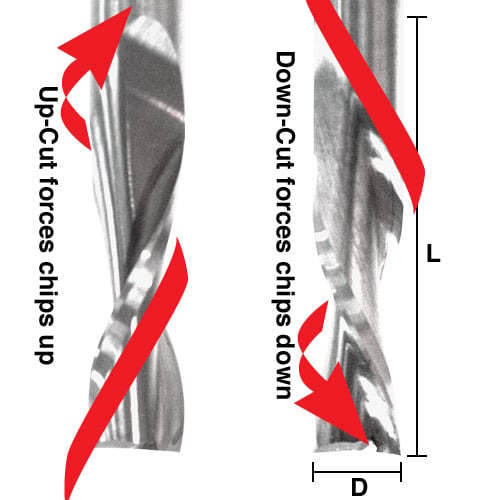
More Splintering and Tear-Out Tips
- The more porous the wood, the more likely it is to splinter.
- Slower, shallower cuts will reduce the splintering.
- Climb Cutting can make tear-out less like than Conventional Milling.
- Spray a sealer like lacquer on the wood to give it a little more support.
Tips to Reduce Overheating
Tired of those annoying burn marks on your edges? Here are some tips to help:
- Make sure you’re running proper feeds and speeds so that your cutters won’t rub. Rubbing generates a lot of heat. You need a Feeds and Speeds Calculator to do the job right. Preferably one like our G-Wizard that has a Rubbing Warning.
- Keep cutters clean. Any dust or resin buildup adds friction which can lead to overheating the material.
- Use sharp cutters. If you can run your fingernail over the edge without shaving off a bit of fingernail, your cutter is probably dull.
- Take shallower passes. Hogging with deep passes removes material fast, but it can also cause tear-out and overheating that leads to burning.
CNC Router or Mill?
Would you believe that for many CNC woodworking applications, a VMC (Vertical Machining Center) or mill can make more sense than a CNC Router? All sorts of companies like Taylor Guitars and Fender are using VMC’s on a daily basis for woodwork. Here are some of the reasons why:
– Cost: When high levels of precision are needed (guitar making is very precise), the mill can achieve precision at a lower price point.
– Floor Space: Most of the gantries are set up to take 4×8 sheets. These custom shops are doing smaller runs and they’re not machining plywood sheets. The desire to include climate control to keep the wood stable also means shop floor square footage is at a premium. Smaller machine footprints help keep this cost under control.
– Dust Control: The full enclosure of a mill really helps keep the dust down in the shop.
– Tool Changer: While they’re certainly available for CNC Routers, they’re common on mills.
Vacuum Table Tips
Vacuum tables are often the preferred method of workholding for wood, and we have a huge page chock full of great information on how to use Vacuum Tables.
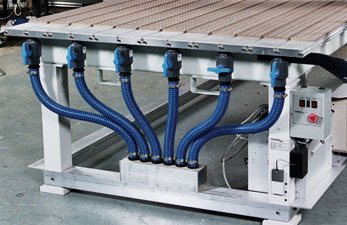
Check out our Total Guide to Vacuum Tables…
Calculating Feeds and Speeds for Wood
Feeds and Speeds Calculator for Wood and CNC Routers
For CNC Woodworking applications, a good Feeds and Speeds Calculator needs the following features:
– A detailed wood database to fine tune Feeds and Speeds by wood species.
– Support for the special cutters used by CNC Routers such as downcut, compression, and straight flute.
– If you have a hobby-class machine, it isn’t as sturdy or rigid as a commercial machine. Feeds and Speeds will need to be adjusted.
– Support to help you limit feeds and speeds to levels that won’t pop the parts of your vacuum table.
Our G-Wizard Calculator is the world’s first feeds and speeds calculator specifically designed for CNC Router use, and it does all that and more.
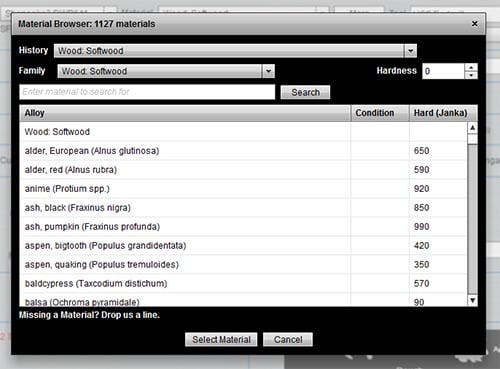
G-Wizard’s Material Database has hundreds of wood species built-in…
My Cutter Gets Really Hot or the Wood is Being Burnt
If the cutter is getting hot to the touch (careful!), and especially if there is any discoloration or the wood is being burnt, your feedrate relative to the proper feedrate is too slow, and the cutter is rubbing. For a full explanation of rubbing, see this article from our Feeds and Speeds Tutorials.
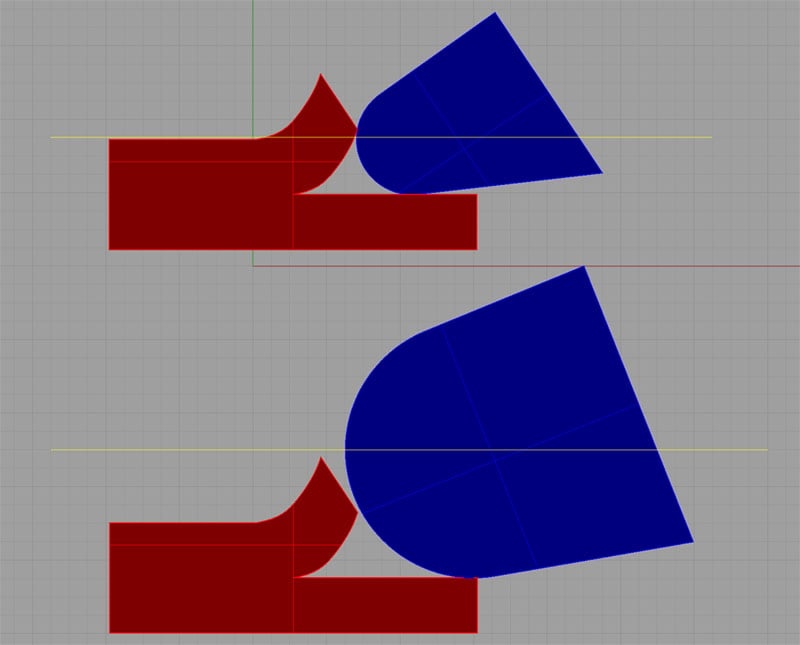
Geometry causes rubbing when we feed cutters too slowly. It heats everything up and will burn wood…
This post originally appeared on the CNC Cookbook blog. Tormach's 24R CNC Router uses the advanced PathPilot® CNC control which uses standard machine code (G & M), integrates with most industry-standard CAD/CAM programming software packages, and includes built-in diagnostics, tool path graphics. That means that you can start making (wood) chips fast and create the parts you want. For more info on the 24R CNC Router check out the technical specs or watch this video.
